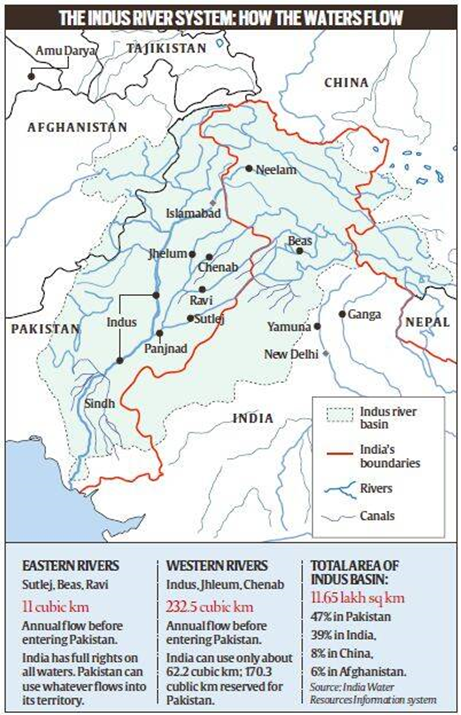In News:
- Recently, India and Pakistan began another round of the Permanent Indus Committee meeting.
- The meeting is held annually under the Indus Water Treaty (IWT) 1960.
What’s in today’s article:
- Background (Need a treaty on Indus river system)
- About IWT (Parties involved, Provisions, Dispute settlement mechanism, etc.)
Background:
- The Indus river basin has six rivers- Indus, Jhelum, Chenab, Ravi, Beas and Sutlej; originating from Tibet and flowing through the Himalayan ranges to enter Pakistan.
- In 1947, the line of partition, aside from delineating geographical boundaries for India and Pakistan, also cut the Indus river system into two.
- Both the sides were dependent on water from the Indus river basin to keep their irrigation infrastructure functional and therefore, equitable distribution was needed.
- Initially, the Inter-dominion Accord of May, 1948 was adopted, where both countries, after meeting for a conference, decided that India would supply water to Pakistan in exchange for an annual payment made by the latter.
- This agreement however, soon disintegrated as both the countries could not agree upon its common interpretations.
- In 1951, in the backdrop of the water-sharing dispute, both the countries applied to the World Bank for funding of their respective irrigation projects on Indus and its tributaries, which is when the World Bank offered to mediate the conflict.
Indus Water Treaty:

- Finally in September 1960, an agreement was reached between the two countries, and the Indus Waters Treaty (IWT) was signed by former Prime Minister Jawaharlal Nehru and then President of Pakistan, Ayub Khan.
Key Provisions of the Treaty:
- The treaty prescribed how water from the six rivers of the Indus River System would be shared between India and Pakistan.
- It allocated the three western rivers—Indus, Chenab and Jhelum—to Pakistan for unrestricted use, barring certain non-consumptive, agricultural and domestic uses by India and the three Eastern rivers—Ravi, Beas and Sutlej—were allocated to India for unrestricted usage.
- This means that 80% of the share of water or about 135 Million Acre Feet (MAF) went to Pakistan, while leaving the rest 33 MAF or 20% of water for use by India.
- It also required both the countries to establish a Permanent Indus Commission constituted by permanent commissioners on both sides.
- The functions of the commission include serving as a forum for exchange of information on the rivers, for continued cooperation and as a first stop for resolution of conflicts.
Hydropower Projects:
- While Pakistan has rights over the waters of Jhelum, Chenab and Indus, Annexure D allows India to build ‘run of the river’ hydropower projects on these rivers, meaning projects not requiring live storage of water.
- It also provides certain design specifications which India has to follow while developing such projects.
- The treaty also allows Pakistan to raise objections over such projects being built by India, if it does not find them to be compliant with the specifications.
- India has to share information on the project design or alterations made to it with Pakistan, which is required to respond with objections, if any, within three months of receipt.
Dispute Resolution Mechanism:
- The IWT also provides a three step dispute resolution mechanism, under which “questions” on both sides can be resolved at the Permanent Commission, or can also be taken up at the inter-government level.
- In case of unresolved questions or “differences” between the countries on water-sharing, either side can approach the World Bank to appoint a Neutral Expert (NE) to come to a decision.
- And eventually, if either party is not satisfied with the NE’s decision or in case of “disputes” in the interpretation and extent of the treaty, matters can be referred to a Court of Arbitration.
Should the IWT be renegotiated?
- Every now and then, there is a clamour in India for abrogating the IWT as a response to Pakistan’s cross-border terrorism and intransigence.
- There have been several instances of terror attacks which could have prompted India, within the Vienna Convention on the Law of Treaties, to withdraw from the IWT.
- With abrogation an option that India is hesitant to take, there is a growing debate to modify the existing IWT.
- While the treaty may have served some purpose at the time it was signed, now with a new set of hydrological realities, advanced engineering methods in dam construction and de-siltation, there is an urgent need to look at it afresh.
Arguments in favour of renegotiation of IWT:
- Poor water development projects have allowed 2-3 MAF of water to easily flow into Pakistan which needs to be urgently utilised.
- Further, out of the total estimated capacity of 11,406 MW electricity that can be harnessed from the three western rivers in Kashmir, only 3034 MW has been tapped so far.
- However, Article XII of the Treaty says that the agreement can be modified only by a duly ratified treaty concluded for that purpose between the two governments.
- Pakistan will see no merit in any modification having already got a good deal in 1960.
- India’s best option, therefore, would be to optimise the provisions of the treaty in its present form.
- IWT does not have a unilateral exit provision, and is supposed to remain in force unless both the countries ratify another mutually agreed pact.









